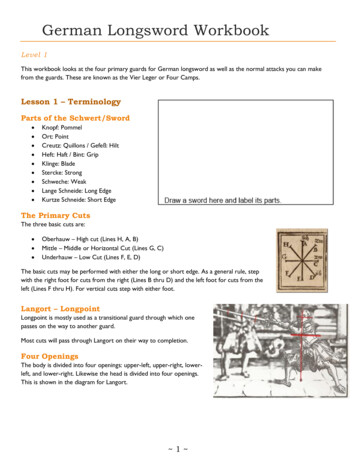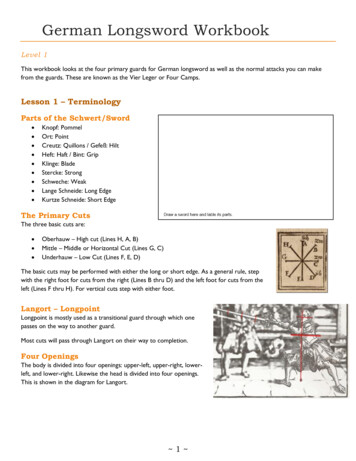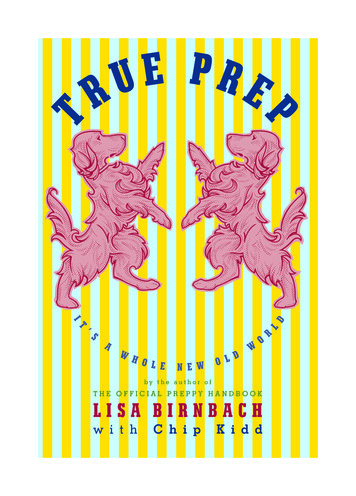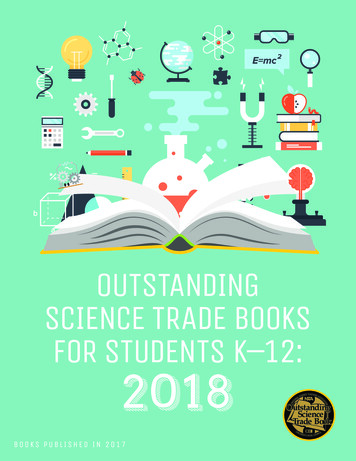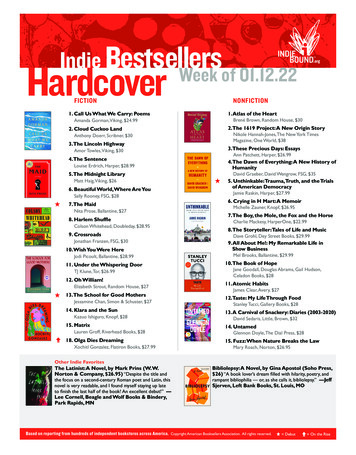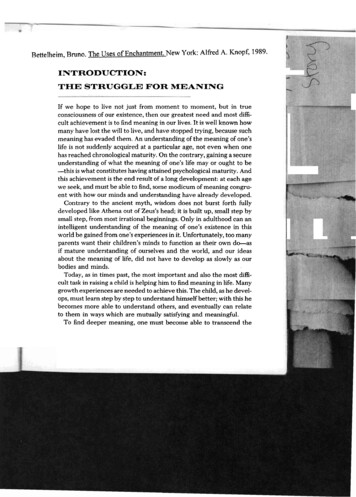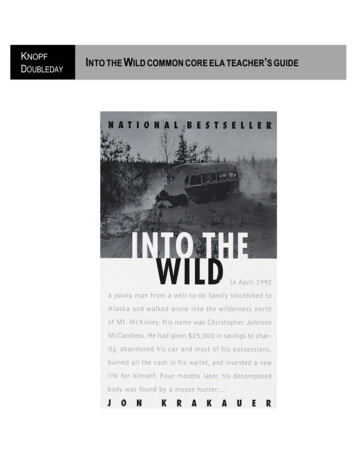
Transcription
R’S%GUIDE
How to use this template to customize your CC ELA Unit using Into The Wild:The curriculum framework below is organized around an extended text, shorter texts and guidingquestions. The categories in bold reflect the curricula recommended by the Common Core framework.The italicized categories, companion texts, digital texts and informational texts, are supplemental contentthat reflect both the Common Core standards and sound educational practice. Engaging students with highinterest texts establishes a foundation upon which to build the rigorous work required to fulfill CommonCore curriculum requirements.This unit contains several Common Core aligned approaches to the text. Select a pathway of study thatbest fits the needs of your students. When deciding which activities to include, consider the duration ofthe unit as well as the learning that preceded and will follow this particular unit. In other words, if youalready have a well-developed research project, you may wish to omit that unit from the template oraddress it in a less time-consuming fashion.Reading the chartsThe first chart [figure 1] provides a broad overview of the unit, including essential questions, guidingquestions, and themes that emerge through the reading of Into The Wild. These lead to several possibleassessments.The second chart [figure 2] includes texts for study (under Reading) and formal assignments (underWriting). Beneath the chart are detailed directions for each task. Texts, assignments and explanations arenumbered for reference. For example, if you want your students to complete the poetry analysis (#4),you’ll find the poems listed under #4 in the reading section and the detailed directions for the assignmentunder #4 beneath the chart.AssessmentDecide what students should know at the conclusion of the unit prior to selecting activities. You maychoose to summatively evaluate student learning across one or more tasks. Assessments are aligned to thecurricular strands outlined to the materials and assignments included in the framework and reflect theCommon Core’s emphasis on research, analytical and informational writing, argument, and narrative.The italicized fields(Companion texts, digital texts, informational texts, digital writing and prerequisite knowledge)You know your students best. What will it take for them to productively engage with the required text?Look for resources that fit under the umbrella of your essential questions and themes and will pique theircuriosity. Does your district encourage and support technology use? The Common Core unit you createcan adapt itself to many digital tools. What will your students need to know in order to complete theactivities you design? By considering prerequisite knowledge, you know what lessons you will need toplan in order to lead your students to success.Standards
Taking the time to identify standards, aligning them with the text, supplementary material or task, willensure that you’ve covered them in depth and will help identify those standards allows your students willneed more exposure to.
Unit Overview: Questions, Themes and AssessmentsEssential QuestionsGuiding QuestionsUnit ThemesPossible AssessmentsHow can the naturalWhat answers might wilderness holdthat can’t be found within the bounds ofcivilization?For some, wilderness holds apromise of answers toquestions from within.Analysis: PoetryIn what ways is risk-taking appealing?Hubris can lead to baddecisions, including takingunnecessary risks.Argument: HubrisLiving deliberately meansevaluating and adjusting one’splace in the world.Argument: Conformity tohigher principleworld provideanswers to humanquestions?Why take risks?What’s the difference between livingdeliberately (close to the edge) andacting recklessly?How can we liveWhat does it mean to live deliberately?deliberately?What does it mean to be self-reliant?Narrative: DesideratumIn what ways do ourrelationships shapeHow do our relationships with ourparents shape us as individuals?The bond between fathers and !sons can be fraught withmisunderstandings.Does truth matter?Being truthful meansacknowledging all sides of thestory.Research: Rebelsus?How do we knowwhat’s true?What is the truth?![figure 1]
Texts for StudyCompanion text(s) - highinterestExtended text!Into The Wild by JonKrakauer2. “Society” (soundtrack) Into TheWild4. Into The Wild (soundtrack)Eddie Vedder4. “Guaranteed” (soundtrack)Eddie Vedder4. “Long Nights” (soundtrack)Eddie Vedder4. “No Ceiling” (soundtrack)Eddie Vedder3-5 short complex texts2. Doctor Zhivago (excerpt)Boris Pasternak[http://bit.ly/1gOwS91]2. Walden “Chapter 2: Wherelived, and what I lived for”(paragraphs 15-17 on livingdeliberately)2. Walden “Chapter 11: HigherPrinciples” (paragraph 7 onconformity to higher principles)2. Into The Wild (excerpt) Chris/Alex’s letter to Ron (p.56-58)2. “Self-Reliance” Emerson(excerpt and penultimateparagraph beginning “And sothe reliance on property.”)4. “Meeting the Mountains”Gary Snyder4. Dharma Bums Kerouac onDesolation Peak, chapter 33,first two paragraphs. e4. “Above Pate Valley”4.! “where water comestogether with other water”Raymond Carver5.!Yellowstone Act - 1872and Theodore Roosevelt atRoosevelt Arch in YellowstoneNational Park (1903) (speech)Digital text(s)Informational text(s)2.!NYT Op-ed: “The Charitable IndustrialComplex” Peter Buffett [http://nyti.ms/17teD0l]1. Jon Krakauer revealsinspiration for Into TheWild [http://bit.ly/1cYQc2s]1. Eye to Eye With KatieCouric: Director SeanPenn (CBS News)[http://bit.ly/1idpKSK]3. Jon Krakauer onOprah Winfrey[http://bit.ly/1j7wmQe]3. “Did Jon KrakauerFinally Solve ‘Into TheWild’ Mystery?” (fromNPR)[http://n.pr/1idqkQe]3.!“Remembering Christopher McCandless20 Years Later” Huffington Post[http://huff.to/1bHvTSh]3. “Examining Chris McCandless, 20 yearsafter he went 'Into the Wild'” (response toHuff Post article from Alaska Dispatch)[http://bit.ly/1cYSzlR]3. “The Cult of Chris McCandless” (fromMen’s Journal) [http://mjm.ag/188aCCh]3. “Into the Wild: 3 hikers rescued nearscene of fatal Alaska adventure” (from LosAngeles Times) [http://lat.ms/1gOzbZI]3. “How Chris McCandless Died” (from TheNew Yorker - this covers the same materialas the NPR interview) [http://nyr.kr/I1l0B7]10. “Why the teen brain is drawn to risk.”Time Magazine[http://ti.me/1gOzTpL]6. Into The Wild directedby Sean Penn6. Iconoclasts: SeanPenn and Jon KrakauerPart1 [http://bit.ly/1cYRj29]6. Iconoclasts: SeanPenn and Jon KrakauerPart 2[http://bit.ly/1bHv4J0][figure 2]
CC Aligned Reading & Listening StandardsThe following 11-12 ELA reading and listening standards are a consistent expectation in all work during the unit: RI.& RL.11-12.1. Cite strong andthorough textual evidence tosupport analysis of what the textsays explicitly as well as inferencesdrawn from the text, includingdetermining where the text leavesmatters uncertain. RI.& RL.11-12.2. Determine twoor more themes or central ideas ofa text and analyze theirdevelopment over the course of thetext, including how they interact andbuild on one another to produce acomplex account; provide anobjective summary of the text. RL.11-12.3. Analyze the impactof the author’s choices regardinghow to develop and relate elementsof a story or drama (e.g., where astory is set, how the action isordered, how the characters areintroduced and developed). RI.11-12.2. Analyze a complexset of ideas or sequence of eventsand explain how specificindividuals, ideas, or events interactand develop over the course of thetext.#2 RI.11-12.4. Determine themeaning of words and phrasesas they are used in a text,including figurative,connotative, and technicalmeanings; analyze how anauthor uses and refines themeaning of a key term or termsover the course of a text#2 RI.11-12.6. Determine anauthor’s point of view orpurpose in a text in which therhetoric is particularly effective,analyzing how style andcontent contribute to thepower, persuasiveness, orbeauty of the text.#2 RL.11-12.9 Demonstrateknowledge of 18th, 19th, andearly 20th-century foundationalworks of American literature,including how two or moretexts from the same periodtreat similar themes or topics# 4 RL.11-12.1. Cite strong andthorough textual evidence tosupport analysis of what the textsays explicitly as well asinferences drawn from the text,including determining where thetext leaves matters uncertain.# 4 RL.11-12.2. Determine two ormore themes or central ideas of atext and analyze theirdevelopment over the course ofthe text, including how theyinteract and build on one anotherto produce a complex account;provide an objective summary ofthe text.# 4 RL.11-12.4. Determine themeaning of words and phrases asthey are used in the text, includingfigurative and connotativemeanings; analyze the impact ofspecific word choices on meaningand tone, including words withmultiple meanings or languagethat is particularly fresh, engagingor beautiful.# 4 RL.11-12.6. Analyze a casein which grasping point of viewrequires distinguishing what isdirectly stated in a text from whatis really meant# 4 RL.11-12.10. By the end ofgrade 11, read and comprehendliterature, including stories,dramas, and poems, in the grades11-CCR text complexity bandproficiently, with scaffolding asneeded at the high end of therange.# 4 L.11-12.5. Demonstrateunderstanding of figurativelanguage, word relationships, andnuances in word meanings.# 5 RI.11-12.8. Delineate andevaluate the reasoning in seminalU.S. texts, including the applicationof constitutional principles and theuse of legal reasoning and thepremises, purposes, andarguments in works of publicadvocacy.# 7& 8 RI.11-12.7 Integrate andevaluate multiple sources ofinformation presented in differentmedia or formats (e.g., visually,quantitatively) as well as in words inorder to address a question orsolve a problem.# 7& 8 RI.11-12.6. Determine anauthor’s point of view or purpose ina text in which the rhetoric isparticularly effective, analyzing howstyle and content contribute to thepower, persuasiveness, or beautyof the text.# 7& 8 SL.11-12.2. Initiate andparticipate effectively in a range ofcollaborative discussions (one- onone, in groups, and teacher-led)with diverse partners on grades 11–12 topics, texts, and issues,building on others’ ideas andexpressing their own clearly andpersuasively.# 3 RI.11-12.7 Integrate andevaluate multiple sources ofinformation presented indifferent media or formats (e.g.,visually, quantitatively) as wellas in words in order to addressa question or solve a problem.# 6 RL11-12.5. Analyze howan author’s choices concerninghow to structure specific partsof a text contribute to its overallstructure and meaning as wellas aesthetic impact.# 6 RI.11-12.7 Integrate andevaluate multiple sources ofinformation presented indifferent media or formats (e.g.,visually, quantitatively) as wellas in words in order to addressa question or solve a problem.# 6 SL.11-12.1. Initiate andparticipate effectively in arange of collaborativediscussions (one- on-one, ingroups, and teacher-led) withdiverse partners on grades 11–12 topics, texts, and issues,building on others’ ideas andexpressing their own clearlyand persuasively.# 3 RI.11-12.1 Cite strong andthorough evidence to supportanalysis of what the text saysexplicitly as well as inferences drawnfrom the text, including where thetext leaves matters uncertain.# 3 RI.11-12.6. Determine anauthor’s point of view or purpose in atext in which the rhetoric isparticularly effective, analyzing howstyle and content contribute to thepower, persuasiveness, or beauty ofthe text.# 3 RI.11-12.7 Integrate andevaluate multiple sources ofinformation presented in differentmedia or formats (e.g., visually,quantitatively) as well as in words inorder to address a question or solvea problem.# 3 RI.11-12.10. By the endofgrade 11, read and comprehendliterary nonfiction in the grades 11CCR text complexity bandproficiently, with scaffolding asneeded at the high end of the range.
Formal AssignmentsResearch Project4-6 Analytical (informational &argument)NarrativePrerequisite Knowledge Library databases Note-taking MLA (or other) style Research writingPrerequisite KnowledgePrerequisite Knowledge !Narrative writing Descriptive writing1. Rebels, Outcasts,Adventurers, Warriors(assessment)2.Conformity to higher principle(assessment)3.Hubris(assessment)4. Poetry/poetic language(assessment)5.President Theodore Roosevelt’s speech& Yellowstone Act (1872)6.Into The Wild (film)MLA (or other) style !Literary terms !Rhetorical techniques !Film techniques !Close Reading !Analytical writing !Argument writing !Public speaking !Vocabulary (see list below)7.Desideratum personalessay(assessment)8.Wild Places (descriptivewriting)!RoutinewritingDigital Writing and Web 2.0possibilitiesPrerequisite Knowledge Web 2.0 Digital Tools9.Journaling (orBlogging)10.10 QuickWrites11. Discussionquestions1,8,9,11. See specifics for digital writingpossibilities below.Research ToolsEvernote [www.evernote.com]Diigo [www.diigo.com]EasyBib [www.easybib.com]Writing ToolsFigment [http://figment.com]Google Drive [https://drive.google.com]Free Annotation AppsiAnnotate PDFNotabilityPaperPort NotesVocabulary ToolsThe Noun Project[http://thenounproject.com]images for a precise infographic.Presentation ToolsEasel.ly [http://www.easel.ly]To create an infographic, a visual depictionof informationPrezi [http://prezi.com]Animoto Video Maker
CC Writing & Speaking StandardsThe following 11-12 ELA writing, speaking and language standards are a consistent expectation in all work during the unit:!! W.11-12.4. Produce clear andcoherent writing in which thedevelopment, organization, and styleare appropriate to task, purpose, andaudience. (Grade-specificexpectations for writing types aredefined in standards 1–3 above.) W.11-12.5. Develop and strengthenwriting as needed by planning,revising, editing, rewriting, or tryinga new approach, focusing onaddressing what is most significantfor a specific purpose and audience.(Editing for conventions shoulddemonstrate command of Languagestandards 1–3 up to and includinggrades 11–12 on page 54.) W.11-12.6. Use technology,including the Internet, to produce,publish, and update individual orshared writing products in responseto ongoing feedback, including newarguments or information. W.11-12.10. Write routinely overextended time frames (time forresearch, reflection, and revision)and shorter time frames (a singlesitting or a day or two) for a range oftasks, purposes, and audiences. L.11-12.1. Demonstrate commandof the conventions of standardEnglish grammar and usage whenwriting or speaking. L.11-12.2. Demonstrate commandof the conventions of standardEnglish capitalization, punctuation,and spelling when writing. L.11-12.3. Apply knowledge oflanguage to understand howlanguage functions in differentcontexts, to make effective choicesfor meaning or style, and tocomprehend more fully when readingor listening. SL.11-12.2. Initiate and participateeffectively in a range of collaborativediscussions (one- on-one, in groups,and teacher-led) with diversepartners on grades 11–12 topics,texts, and issues, building on others’ideas and expressing their ownclearly and persuasively. SL.11-12.6. Adapt speech to avariety of contexts and tasks,demonstrating a command of formalEnglish when indicated orappropriate.# 1 W.11-12.7. Conduct shortas well as more sustainedresearch projects to answer aquestion (including a selfgenerated question) or solve aproblem; narrow or broadenthe inquiry when appropriate;synthesize multiple sources onthe subject, demonstratingunderstanding of the subjectunder investigation.# 1 W.11-12.8. Gatherrelevant information frommultiple authoritative print anddigital sources, using advancedsearches effectively; assessthe strengths and limitations ofeach source in terms of thetask, purpose, and audience;integrate information into thetext selectively to maintain theflow of ideas, avoidingplagiarism and overreliance onany one source and following astandard format for citation.# 2&3 W.11-12.1. Writearguments to support claims in ananalysis of substantive topics ortexts, using valid reasoning andrelevant and sufficient evidence.Explore and inquire into areas ofinterest to formulate an argument.# 2&3 W.11-12.7.9. Drawevidence from literary orinformational texts to supportanalysis, reflection, and research.# 4&5 W.11-12.7.9. Drawevidence from literary orinformational texts to supportanalysis, reflection, and research.# 4&5 SL.11-12.4. Presentclaims and findings, emphasizingsalient points in a focused,coherent manner with relevantevidence, sound valid reasoning,and well-chosen details; useappropriate eye contact, adequatevolume, and clear pronunciation.# 4&5 W.11-12.7.2. Writeinformative/explanatory texts toexamine and convey complexideas, concepts, and informationclearly and accurately through theeffective selection, organization,and analysis of content.# 6 W.11-12.7.2. Writeinformative/explanatory texts toexamine and convey complexideas, concepts, and informationclearly and accurately through theeffective selection, organization,and analysis of content.#7&8 W.11-12.3. Write narrativesto develop real or imaginedexperiences or events usingeffective technique, well-chosendetails, and well-structured eventsequences.# 8 SL.11-12.4. Present claimsand findings, emphasizing salientpoints in a focused, coherentmanner with relevant evidence,sound valid reasoning, and wellchosen details; use appropriate eyecontact, adequate volume, andclear pronunciation.# 8 SL.11-12.5. Integratemultimedia and visual displays intopresentations to clarify information,strengthen claims and evidence,and add interest.# 9 L.11-12.3. Applyknowledge of language tounderstand how languagefunctions in different contexts,to make effective choices formeaning and style, and tocomprehend more fully whenreading and listening.# 9&10 W.11-12.10. Writeroutinely over extended timeframes (time for research,reflection, and revision) andshorter time frames (a singlesitting or a day or two) for arange of tasks, purposes, andaudiences.#10 W.11-12.1 a-e- Writearguments to support claims inan analysis of substantivetopics or texts, using validreasoning and relevant andsufficient evidence.# 10 W.11-12.9. Drawevidence from literary orinformational texts to supportanalysis, reflection, andresearch.# 11 SL.11-12.1. Initiate andparticipate effectively in arange of collaborativediscussions (one- on-one, ingroups, and teacher-led) withdiverse partners on grades 11–12 topics, texts, and issues,building on others’ ideas andexpressing their own clearlyand persuasively#11 SL.11-12.2. Analyze thepurpose of informationpresented in diverse media andformats# 11 W.11-12.6. Usetechnology, including theInternet, to produce, publish,and update individual or sharedwriting products in response toongoing feedback, includingnew arguments or information.W.11-12.6. Use technology, includingthe Internet, to produce, publish, andupdate individual or shared writingproducts in response to ongoingfeedback, including new argumentsor information.
Research Project1.!Rebels, Outcasts, Adventurers, Social and Environmental WarriorsUse this research unit to introduce students to individuals who resist social conformity beforereading the book. After reading Into The Wild, ask students to compare and contrast the personthey researched with Chris McCandless. What values did they share? Where did their idealsdiffer? What was the outcome of their actions? What could they have learned from one another?Share the videos of Jon Krakauer and Sean Penn discussing what drew them to the story of Christo demonstrate how professional writers and directors start their creative processes. These clipswill also introduce students to Chris.After he ditches his car and gives away his trust fund, Chris McCandless steps off the road into theAlaskan wilderness carrying only what will fit in his backpack. In doing so, he joined a small butcommitted group of individuals who in some way reject the ideals and lifestyle of modern America (ortheir culture). Who are these individuals? What are they looking for? Why are they dissatisfied with theirlives or the way others live? For this project, you’ll choose one rebel, outcast, extreme adventurer orsocial/environmental warrior to research and write about.Using your school’s library databases, locate several articles about the individual you have chosen toresearch. After reading them, be prepared to answer the following questions. Who steps out of thetraditional bounds of society and why? What do they hope to accomplish? What do they find? How doessociety respond to them?(Ideally, students select their own rebels, but the list below is a start. Encourage students to seek outindividuals that are of interest to them. These “rebels” need only to have visibly pushed back against thestatus quo in some way.)Henry David Thoreau, Edward Abbey, Jack Kerouac, Captain Paul Watson, Cheryl Strayed,Anne LaBastille, Beryl Markham, Ayaan Hirsi Ali, Edward Snowden, John Muir, TimothyTreadwell, Ted Kaczynski, Paul Gauguin, Allen Ginsberg, George Carlin, Bill Hicks, DanielEllsberg, Mahatma Gandhi, Thomas Morton (see Hawthorne’s “The Maypole of Merry Mount”),St. Francis, Hermann Hesse (see Siddartha), John Brown, Che Guevara, Nelson Mandela, Ho ChiMinh, Galileo Galilei, Sitting Bull, Crazy Horse, Martin Luther, Martin Luther King, Jr., WilliamWallace, George Washington . . .Once you have a comprehensive understanding of the person you have chosen to research, write a welldeveloped essay about him or her. In your essay you should analyze this individual’s choice to live oroperate outside the usual bounds of society. Your thesis should address at least one the following: Didthis individual find success on his or her quest? What stumbling blocks did this person encounter alongthe way? What did this individual learn? What did others learn from this individual? Be sure to supportyour argument with specific and relevant evidence from the researched information you found, citing thematerial accordingly.
Make it digital and practice public speaking: Require students to create short digital presentations to sharewith their peers. Return to these at the conclusion of the unit and evaluate Chris’ choices in light of otherswho choose to live outside boundaries of what is traditional.
Argument/Information2.!Conformity to higher principle (living deliberately) (possible assessment)Introduce this writing assignment to students with the song “Society” off the Into The Wildsoundtrack, analyzing the prompt and modeling close reading, or include the lyrics into the list oftexts.Scaffold this assignment by providing students with a passage from Into The Wild. The letterfrom Chris/Alex to Ron found on pages 56-58 works well.In his essay on self-reliance, Ralph Waldo Emerson writes, “Nothing can bring you peace but yourself.Nothing can bring you peace but the triumph of principle.” Like Emerson and Henry David Thoreau,Chris McCandless chooses to live deliberately. In doing so he estranges himself from his family andothers who do not understand his desire to live by these higher principles. Write an essay in which youconsider what it means to live deliberately and decide if Chris lived up to these standards. Consider thefollowing documents: the excerpt from Doctor Zhivago, the two excerpts from Walden, the excerpt fromSelf-Reliance, The New York Times Op-Ed, “The Charitable Industrial Complex” and Into The Wild.3.!Hubris (possible assessment)Help students see both sides to this story by introducing this assignment with Krakauer’s interview onOprah. Although Krakauer clearly lands in the pro-McCandless camp, he acknowledges that others do notgive Chris as much credit.One theme explored in depth throughout Into The Wild is the fine line between hubris (excessive pride orself-confidence) and deliberately living one’s life on the edge. A number of Alaskans argue that ChrisMcCandless brought about his own demise by going into the wild without sufficient respect for thewilderness. Others believe that Chris understood the risks he took and that he did so deliberately becausehe wished to push himself to the limits of his ability. Did Chris act recklessly when he walked into theAlaskan wilderness or did his actions reflect the certitude of an individual testing his own fortitude? Writean essay in which you develop a thesis (an argument) about Chris’s actions, specifically whether theyconstitute hubris or a deliberate risk. Consider the information provided -- including the source -- in thefollowing documents: “Remembering Christopher McCandless 20 Years Later,” “Examining ChrisMcCandless, 20 Years After He Went ‘Into The Wild,’” Into the Wild: 3 Hikers Rescued Near Scene ofFatal Alaska Adventure,” the video excerpt of Jon Krakauer’s appearance on Oprah (if not used tointroduce the assignment), “Did Krakauer Finally Solve ‘Into The Wild’ Mystery” or “How ChrisMcCandless Died,” and Into The Wild. Be sure to distinguish your claim from opposing claims, supportyour argument with at least four of the documents (including the book) and cite your sources.4.!Poetry/Poetic language: Close readingScaffold this activity by practicing close reading with students prior to beginning analysis of these
poems. Three songs from the Into The Wild soundtrack, “Guaranteed,” “Long Nights,” and “NoCeiling,” lend themselves to close reading.
Literary terms and techniques explicitly addressed in the questions below: imagery, figurativelanguage, tone, repetition, metaphor, theme, word choice, style.To familiarize students with the text-based literary analysis, ask them to write a brief response to thepoems below in which they identify one effect intended by the author and analyze how the author’s use ofone literary element or technique advances this effect. Students should support their analysis withevidence from the poem.Additionally, analyzing the content of these poems (and the excerpt from Dharma Bums) can help leadstudents to a richer understanding of Chris’s experience. Use the questions to help students to closely readthe poems and draw parallels or make contrasts between the texts.a. Dharma Bums (excerpt) - What does Kerouac means when he is upside-down, literally andfiguratively? What is the effect of this image upon the meaning of the passage? What is the tone of thispassage?b. “Above Pate Valley” - What does the speaker of the poem find on the trail? What parallel does thespeaker of the poem draw between himself and his subject? How does Snyder use repetition to establishthis?c. “where water comes together with other water” —What is the tone of this poem? Rivers are the subjectof the poem, but they also function as a metaphor. Explain how the metaphor functions. How does thepoet’s figurative language lead the reader to a more complete understanding his message (theme)?d. “Meeting the mountains”—The word meeting has multiple meanings. How does each alter ourunderstanding of the poem? What other words might have Snyder chosen? How would they alter themeaning of the title? What is the effect of the poet’s style, especially the way he chooses to introduce thefirst four lines? What is the poet’s attitude toward his subject?Implementation idea for analyzing individual poems: model, partner, independent, assessment5.!The Yellowstone Act (1872) (A) and Theodore Roosevelt’s Speech at Yellowstone National Park(B)!- close readingAnalyze the text of the law prior to reading Theodore Roosevelt’s speech. Then, when reading thespeech, in addition to to the the text-based analysis, ask students to consider how Rooseveltsupports the tenets established in the Yellowstone Act at the dedication of the Roosevelt Archthirty-one years later.A.!To familiarize students with the reasoning and language of legal texts, ask students write a briefresponse to the Yellowstone Act, identifying the purpose and parameters of the law. What does the lawpurport to do and how?Teachers may wish to practice close reading with students prior to beginning analysis of thisspeech. In this case, ask students to pay particular attention to how writers establish their claims.What specific examples do they include to support their argument? Rhetorical techniques
explicitly addressed: theme.To help students visualize the scene, show this short PBS video, Theodore Roosevelt Speaks atYellowstone Arch: [http://www.pbs.org/nationalparks/history/ep2/4/]
Additionally, analyzing the content of this speech can help lead students to a richer understandingof the context of Into The Wild. Given Chris’s affinity for wild places as well as his aversion toconsumerism, how do you think he would react to Roosevelt’s speech? A number of the placesChris visits are protected as “forever wild” under our country’s system of national parks. Howdoes this legacy allow individuals like Chris to live his life more fully?B.!To familiarize students with the text-based literary analysis, ask them to write a brief response toTheodore Roosevelt’s Speech at Yellowstone National Park in which they identify one effect intended bythe author and analyze how the author advances this effect. Students should support their analysis withevidence from the speech.What does President Theodore Roosevelt tell Americans in his speech? What message (theme) does hewant them to walk away knowing? What points does he make in order to persuade his audience of hisposition? How do these examples advance his message?C.!To extend this analysis, discuss how Chris might respond to the legislation that led to the creation ofthe National Park system (the Stampede trail lies just outside the boundary of Denali National Park andPreserve) and what President Teddy Roosevelt had to say about it at the turn of the century.6.!The film version of Into The Wild - close readingView the video of Sean
Texts for Study Extended text Companion text(s) - high interest 3-5 short complex texts Digital text(s) Informational text(s) Into The Wild by Jon Krakauer l 2. “Society”




